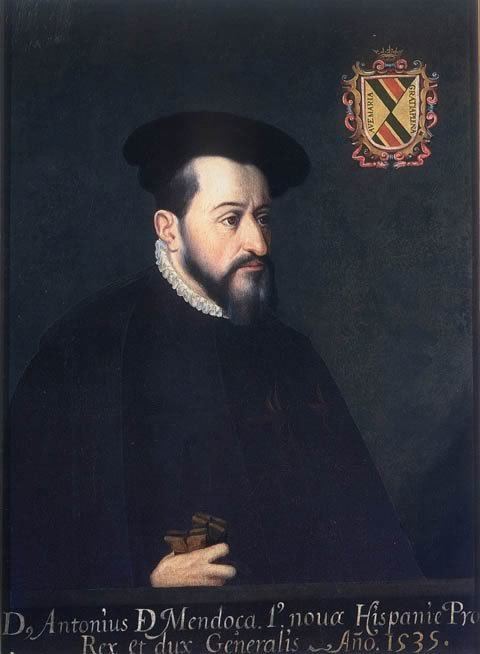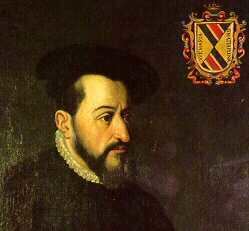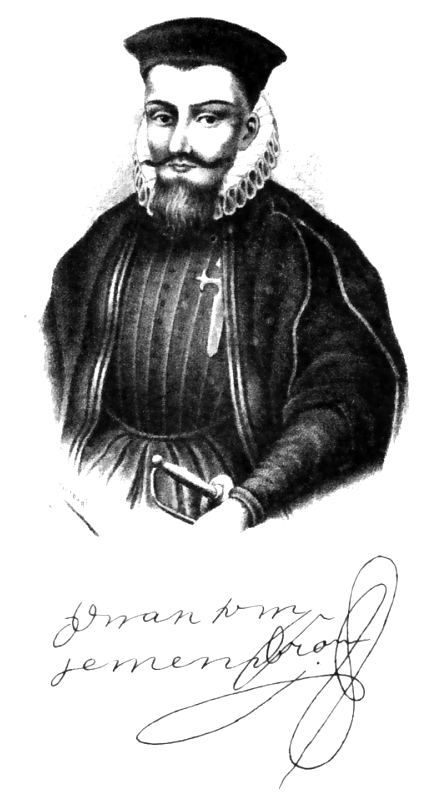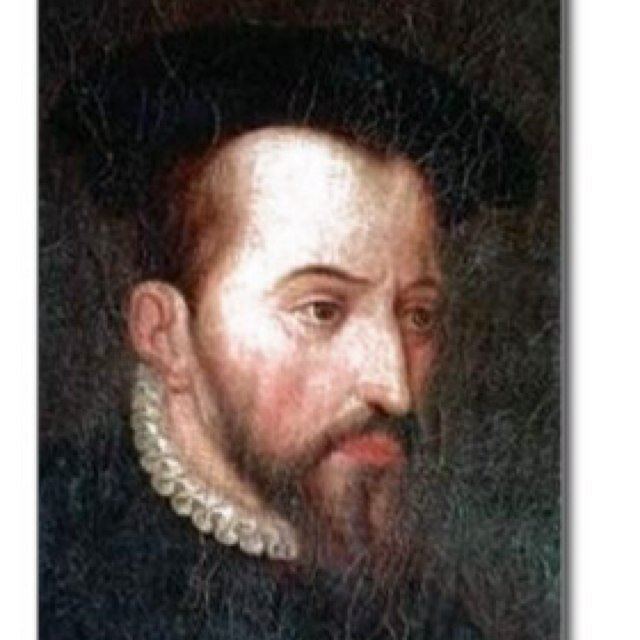Name Antonio Mendoza | Succeeded by Luis de Velasco | |
 | ||
Full Name Antonio de Mendoza y Pacheco Similar People Luis de Velasco, Blasco Nunez Vela, Juan O'Donoju, Andres Hurtado de Mendoza, Hernan Cortes | ||
Antonio de mendoza bio
Antonio de Mendoza y Pacheco (Spanish: Antonio de Mendoza) (1495 – July 21, 1552) was the first Viceroy of New Spain, serving from April 17, 1535 to November 25, 1550, and the third Viceroy of Peru, from September 23, 1551, until his death on July 21, 1552.
Contents
- Antonio de mendoza bio
- 25 0116 El virrey Luis de Velasco inaugura la Real y Pontificia Universidad de la Nueva Espaa
- Viceroy of New Spain
- Viceroy of Peru
- References

Mendoza was born at Alcalá la Real (Jaén, Spain), the son of the Second Conde de Tendilla, Íñigo López de Mendoza y Quiñones and Francisca Pacheco. He was married to María Ana de Trujillo de Mendoza.

25/ 01/16 El virrey Luis de Velasco inaugura la Real y Pontificia Universidad de la Nueva España
Viceroy of New Spain

Mendoza became Viceroy of New Spain in 1535 and governed for 15 years, longer than any subsequent viceroy. On his arrival in New Spain, he found a recently conquered territory beset with Indian unrest and rivalry among the Spanish conquerors and Spanish settlers. His difficult assignment was to govern in the king's name without making an enemy of Hernando Cortés. Cortés himself had expected to be made the permanent ruling crown official of New Spain, since he had led the Spanish conquest of the Aztec Empire. The Emperor Charles V (King Charles I of Spain) and the Council of the Indies judged Cortés too independent of crown authority to be made viceroy and had created a high court (audiencia) in New Spain in 1528, appointing Nuño de Guzmán, a rival of Cortés as its president to counter Cortés's power. In 1530 the crown granted Cortés the title of the Marquis of the Valley of Oaxaca with multiple encomiendas. With the arrival of Viceroy Mendoza in 1535, Cortés pursued his own economic interests from his palace in Cuernavaca.

Although the Spanish had occupied and expanded explorations, conquest, and settlement in the Caribbean, it was not until the conquest of central Mexico that the crown appointed a viceroy (vice king), who would be the king's living image in Mexico and envisioned to effectively assert royal authority in the Kingdom of New Spain. Mendoza's status as a noble and his family's loyalty to the Spanish crown made him a suitable candidate for appointment.
Don Antonio and Bishop Juan de Zumárraga were key in the formation of two institutions of Mexico: the Colegio de Santa Cruz at Tlatelolco (1536), where the sons of Aztec nobles studied Latin, rhetoric, philosophy and music, and the Royal and Pontifical University of Mexico (1552), modeled on the University of Salamanca, which trained young men for the Catholic Church. These institutions were the first and second universities respectively to be established in the mainland of the Americas. In 1536 he began the minting of silver and copper coins, known as macuquinas. Also under his instructions, the first printing press in the New World was brought to Mexico in 1539, by printer Juan Pablos (Giovanni Paoli). The first book printed in Mexico: La Escala Espiritual de San Juan Clímaco. On May 18, 1541 don Antonio founded the city of Valladolid (now Morelia, Michoacán).
When the Spanish crown issued the New Laws that put restrictions on the grants of elite conquerors awarded grants of labor encomenderos, the viceroy prudently refrained from implementing the most draconian aspects of the edicts, which no longer permitted an encomendero family holding the grant in perpetuity. In Peru, the implementation of the New Laws resulted in outright rebellion and the assassination of the viceroy. Mendoza's policy of obedezco pero no cumplo ("I obey but do not comply") meant "I respect the authority of the crown, but in my judgment I do not implement particular legislation."
In 1542 an insurrection of the Indians, called the Mixtón Rebellion threatened to push the Spaniards out of northwestern Mexico, bringing the area under indigenous control. The Viceroy himself had to take the field and bring all disposable manpower. The rebellion was quenched and the surviving Indians were harshly punished. By the viceroy's order men, women and children were seized and executed, some by cannon fire, some torn apart by dogs, and others stabbed. In 1548 he suppressed an uprising of the Zapotecs.
As viceroy, Mendoza commissioned the expedition of Francisco Vásquez de Coronado to explore and establish settlements in the northern lands of New Spain in 1540-42, the expedition of Juan Rodríguez Cabrillo to explore the western coastline of Alta California in 1542-43, and the expedition of Ruy López de Villalobos to the Philippines in 1542-43. The Codex Mendoza is named for him. He probably commissioned it.
During his term of office, Mendoza is credited with consolidating the sovereignty of the Crown throughout the Spanish conquests in New Spain and limiting the power and ambition of the first conquistadors. Many of the political and economic policies he established endured throughout the entire colonial period. He promoted the construction of hospitals and schools and encouraged improvements in agriculture, ranching and mining. His administration did much to bring stability and peace to New Spain. He died in Lima.
He was succeeded as viceroy of New Spain by Don Luis de Velasco. It is reported that his advice to his successor was: "Do little and do that slowly."
Viceroy of Peru
On July 4, 1549 in Brussels, Emperor Charles V named Mendoza viceroy of Peru. He traveled overland from Mexico to Panama, and then by boat to Peru. He arrived and took up his new office on November 25, 1550. However, he soon became ill, and died in 1552. His tomb is in the Cathedral of Lima, along with that of the Spanish conqueror of Peru, Francisco Pizarro.
Mendocino County, California and Mendocino National Forest are named in his honor.
